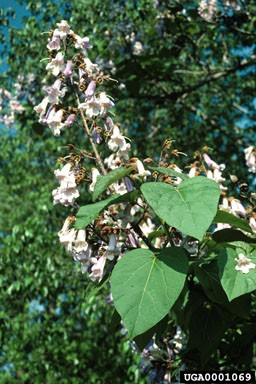Paulownia

Introduction
Also known as empress tree or royal paulownia, it was imported to Europe by the Dutch East India Company in the 1830s and to North America soon after. Historical records describe important medicinal, ornamental and timber uses of Princess tree as early as the 3rd century B.C. Its ability to sprout prolifically from adventitious buds on stems and roots allows it to survive fire, cutting and even bulldozing in construction areas. It is highly prized for carving.
Identification
Princess tree (Paulownia tomentosa) has large heart shape leaves, showy purple flowers in spring, and rounded woody seed pods.
Current Situation
Princess tree occurs throughout much of the eastern United States from Texas to New England where it can be found growing along roadsides, stream banks and forest edges. It tolerates infertile and acid soils and drought conditions and adapts to a wide variety of habitats.
Management
Young plants can be pulled by hand; cut larger trees at ground level with power or manual saw, preferably prior to seed formation to prevent further spread. Systemic herbicides containing glyphosate or triclopyr are effective and can be applied to cut stumps or to bark.
What Can You Do?
Do not plant princess tree.